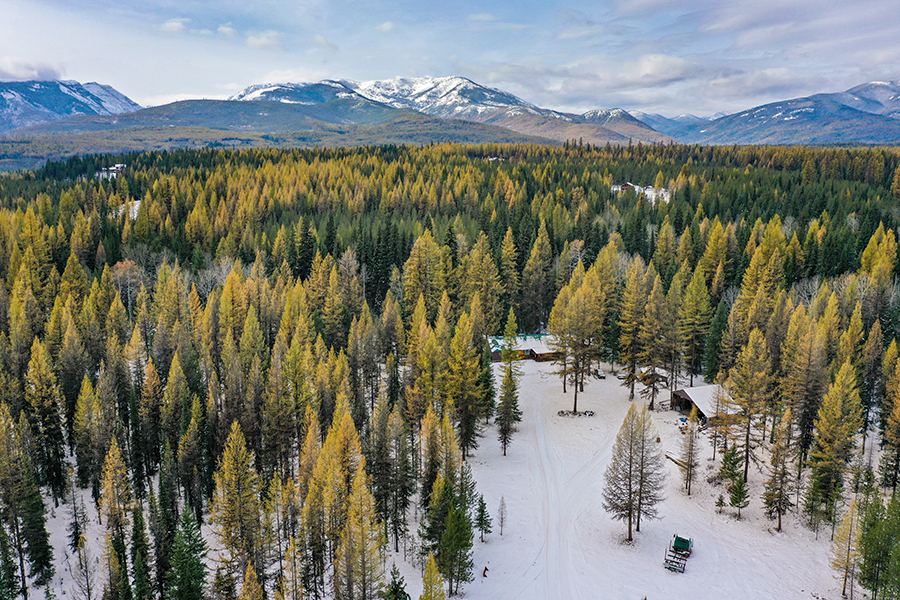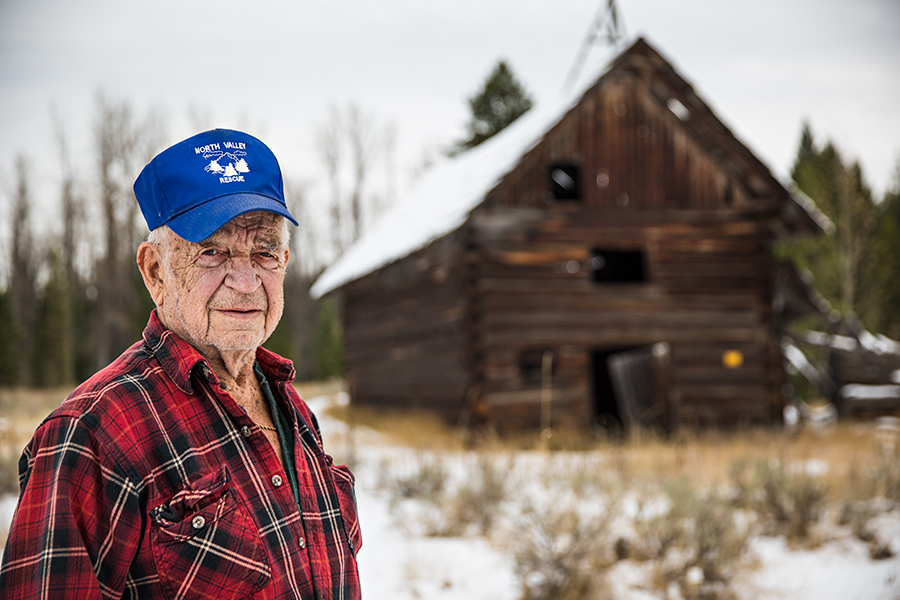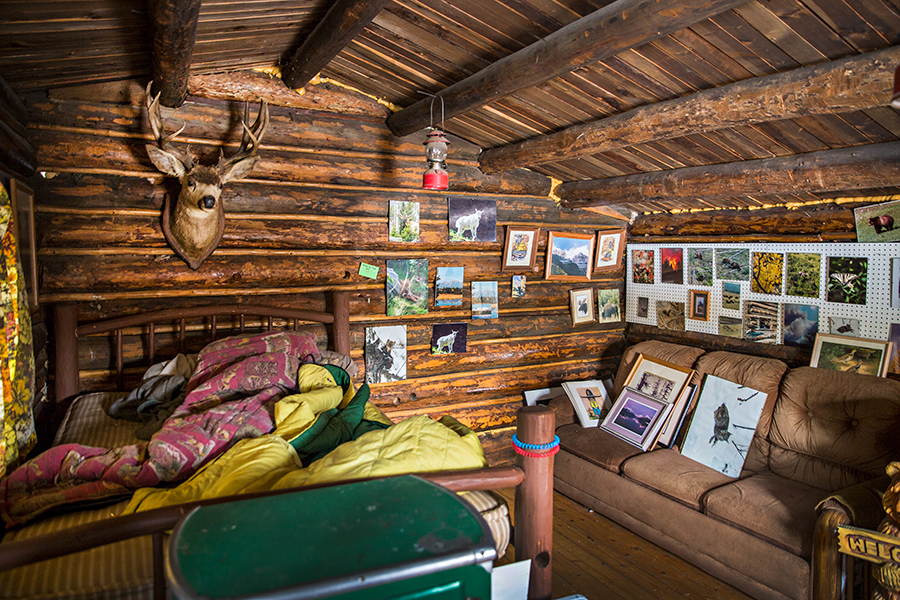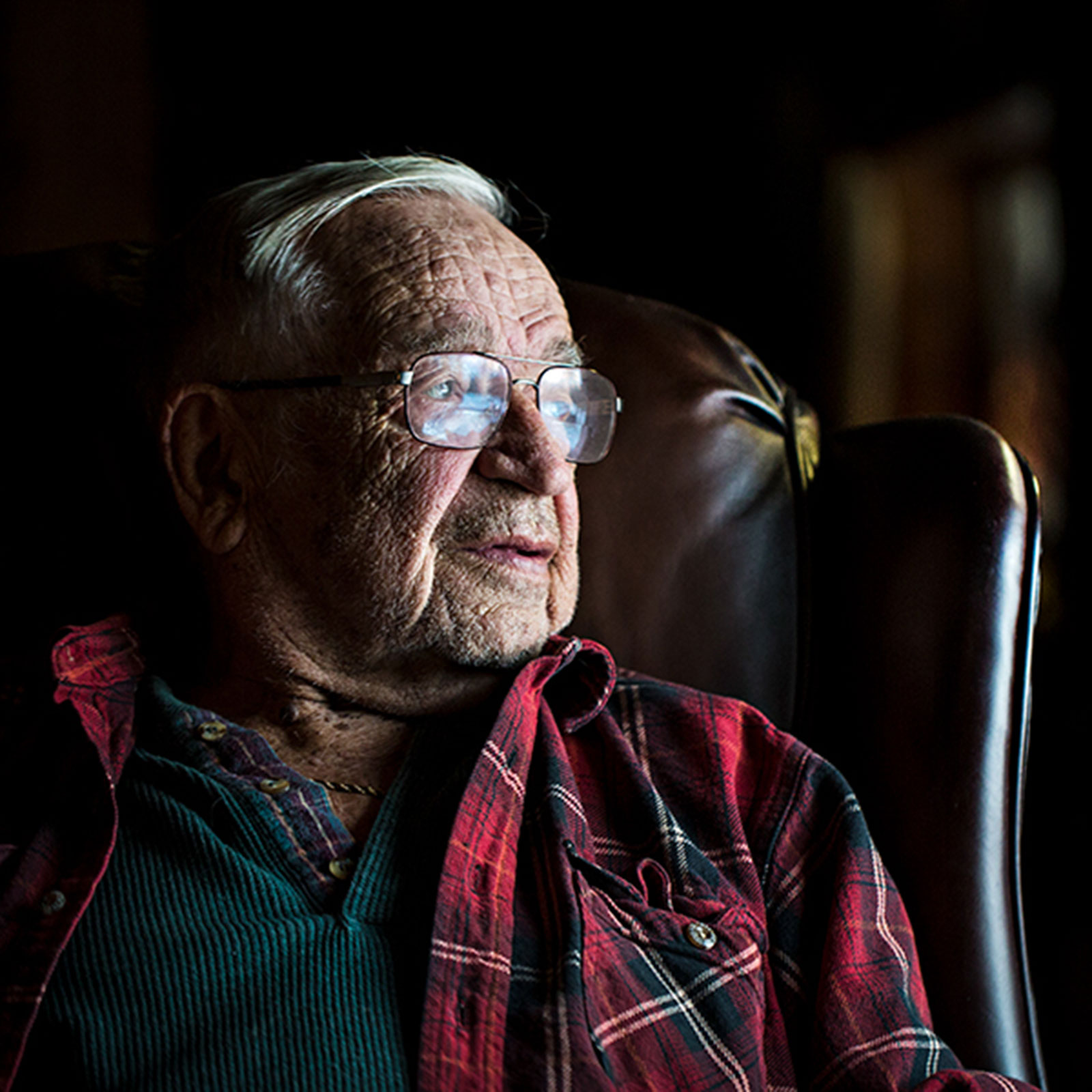There’s an old man who lives way up the North Fork, practically in Canada. He’s been there for 73 years, longer than anyone else who’s still alive. He lives in a three-room log cabin he built in the 1960s for $500; skulls and mounts of just about everything that has ever lived in those woods line his walls. After spending his teenage years hitching rides up and down the North Fork Road on logging trucks, he eventually went to work in the woods himself, running Larry’s Post and Pole for 30 years. He eventually added an indoor shower at his cabin after the smell of his unwashed crew, who worked for a week between trips to town, was just too much. But he didn’t bother with a toilet for years after that, until he experienced the flu in the dead of winter with only an outhouse. His generator now powers a satellite TV, a far cry from the days when his dad would run a wire from the car radio to a barbed wire fence, amplifying the antenna so they could hear the Joe Louis fights. But anyone who wants to visit still has to just show up.
“I don’t need a phone,” he says. “I come up here to get away from the damn thing.”
He’s not shy about his opinions, from believing that grizzlies should be de-listed to how Glacier National Park gave the homesteaders who had settled on the east side of the river a raw deal: “The park would appraise the homestead and then offer one third of the appraised value. And some of the ladies whose husbands had died, they were widows, that was the only asset they had. The park made it difficult if not impossible for anybody else to buy, so they were forced into selling.”
He also has an idea about the North Fork for the throngs of tourists who flooded Montana this summer: “Go to Mexico instead.”
Then there’s this other old man. He also grew up spending all his free time on his family’s North Fork property. He went away to Missoula for college but returned to the valley to teach junior high in Columbia Falls for 14 years. His history is interwoven with nearly every aspect of leadership in the north end of the county: Columbia Falls school board member and president, police commission, North Valley Search and Rescue, city parks superintendent, North Valley Hospital board member, special deputy for the sheriff’s department, columnist for the Hungry Horse News. His gravelly, thoughtfully paced speech calls to mind the radio personality Paul Harvey; he commands attention without demanding it. His mantra is, “You can disagree, but you can’t be disagreeable,” which articulates his deeply held belief in the distinction between being like-minded and getting along.
In addition to his civic involvement, he’s mentored local boys for 60 years, taking in more than a dozen of them for various reasons and lengths of time and ultimately adopting one, his son David. Due to his love of the North Fork and the summers he still spends up there, he’s been active in the North Fork Landowners Association and a wide variety of land-use committees. He was deeply and patiently involved in the 20-year process that led to the current North Fork zoning regulations to limit development and preserve the area’s unique rugged beauty.
He sometimes wishes he could take the North Fork 20 years back in time, but also realizes he can’t fault the area’s more recent arrivals.
“Although I’m opposed to the fact that we’re getting so many people, most of the people I like,” he says. “They’re here for the same reason I am. So how am I qualified to say, ‘Okay I got mine, now you can’t have yours.’”
Those two wildly different characters are both Larry Wilson.

That’s the thing about the North Fork: you can tell its stories two ways, and somehow they’re both true. Wilson, 83, certainly has plenty of stories to tell, both about his life and the characters he’s known. Born in Kalispell in 1938, his family followed his father, Ross, from base to base during World War II before the young lieutenant deployed with the 10th Mountain Division. After the war, Ross acquired a half interest in the Kintla Guest Ranch, a stretch of homesteaded riverfront property and cabins about six miles south of the border. The Wilsons had a house in Kalispell, where young Wilson attended school, but spent their summers in the North Fork. Ross was a game warden and later the Flathead County sheriff; Wilson’s mother, Louise, ran the guest ranch, which saw the same Montana families return year after year to hunt and fish. And if you think the road to Polebridge is hard to drive now, you should have seen it in the early ’50s.
“My mother went to town once a week for fresh produce. She and the one logger’s wife that cooked for their camp were known as the terrors of the road because they could make it to town in two and a half hours,” Wilson says, explaining that the North Fork Road in those days was much like Glacier Park’s Inside North Fork Road still is, “grass growing in the middle and bumps and stumps, stumps and rocks — you know, whatever! It was a horrible road.” As seniors in high school, Wilson and his good friend Bob Gornick would comb through the junkyard behind the Blue Moon for Model A tires before heading north in Gornick’s old truck. “We usually got about seven flats a trip,” Wilson says.
It’s easy to assume that the year-round residents, choosing to live far up a nearly unnavigable road, were somewhere on the social spectrum between loner and hermit. The first homesteaders, who arrived in the early 1900s, were a hardy, self-sufficient bunch who didn’t see any point in living right up against their neighbors. But the early settlers also relied on one another to make it through life in the beautiful but unyielding wilderness — to get a roof on before winter, pull a wagon or a Studebaker out of the mud, to help with kids and farm chores in times of sickness. And when they carved out time to socialize, their parties were, in modern parlance, pretty epic.
“There was one dance a month, the first Saturday,” Wilson recounts. “The Hunt Orchestra came up out of Kalispell. Well, they were called the Hunt Orchestra — it was Mr. and Mrs. Hunt. He played the fiddle; she played the piano. They had a caller and a drummer, and everyone would dance until midnight and then have a midnight supper and dance until the sun came up.”

During Wilson’s childhood, the dances alternated between the Quarter Circle MC Dude Ranch on the east side of the river — in the Big Prairie area of Glacier Park — and Kintla Guest Ranch. Wilson remembers being put in charge of entrance fees alongside the youngest MacFarland, whose family owned the Quarter Circle, stapling a green ribbon to each neighbor’s lapel after collecting their dollar. He also recalls investigating what the men were up to.
“There was no booze allowed in the building, but the guys always had a bottle outside. They’d go out and drink straight whiskey. That’s where I got my first drink of whiskey, from Charlie Wise when I was 10 years old. He said, ‘You won’t like this,’ and he was right!” Wilson chuckles.
As the evenings wore on, the kids would sit on the balcony and watch the dancers before curling up among the coats in the upstairs bedrooms until their parents were ready to head home.
The Wilsons sold the ranch in 1954; Ross was busy as game warden and Louise was tired of hospitality life. The new owner, a Kentucky man, bought it as a tax advantage with no plans to run the guest ranch, but he hired high schoolers Wilson and Gornick as summer caretakers. They spent the long, warm days fording the river on horseback. They would “go into the park and bushwhack, just to see where we could go,” while picking huckleberries “and ripping off the tourists — we sold them for $9 a gallon, and they were $5 in town” and renting the occasional cabin to day trippers who didn’t want to drive back to Kalispell. At the end of the summer, Wilson had $100, which bought his first 10 acres of North Fork land. His home sits on those acres today, just slightly uphill from the original one-room homesteader cabin and about a mile up the road from where the Kintla Guest Ranch once stood.
Wilson bought in on the front end of a trend. As post-World War II Americans found themselves with more disposable income and time, the allure of the North Fork’s rugged beauty outweighed the teeth-rattling road and the complexities of off-the-grid living. But most newcomers didn’t need an entire 160-acre homestead, so they would sell half “for the same price they’d paid for the whole 160,” Wilson says. “And that way they were in free, and the new people had paid double what they had paid. Well, it just went to where, all of a sudden, we had 20-acre lots, then 10-acre lots, then 1-acre lots.” And then in the late 1970s, some people started talking about zoning.
“Zoning was a cuss word,” remembers Cecily McNeil, one of the leaders of the movement. “One of my neighbors on Whale Creek said, ‘If anybody tells me what to do with my land, I’m going to shoot them!’”
“A lot of the locals were buying property to subdivide for development,” Wilson explains, saying that even his father, a lifelong outdoorsman, had bought back into the North Fork with a plan to augment his retirement by selling 1-acre river lots. The issue would come to a head each year when the landowners’ association held its annual elections. McNeil and her team supported zoning, while Wilson’s father Ross led the group opposed to it.
“The August meeting would have maybe 200 people,” Wilson recalls. “Both groups would come in force, trying to elect their slate. [That first year] my dad’s group won and then Cecily and her group left and didn’t come back until next August, for the next election.”

After watching the fight for a few years, Wilson and a few others put together a coalition to bring everyone together. They slowly worked from voluntary land-use guidelines to enforceable ones, resulting in the current zoning ordinances, the most important of which is that land can no longer be subdivided into smaller than 20-acre parcels. Almost everyone eventually came around to the importance of enforceable rules to preserve the character of the North Fork, even Ross Wilson.
“By that time he was older, he was financially secure, and it wasn’t as important,” Wilson recalls. “It’s hard to just label my dad a developer because he was all his life an outdoorsman; he was a game warden, a hunter, a fisherman, you know, all of those things, so it’s a mixed bag.”
Wilson’s ability to recognize all of the aspects that play into decision-making is a large part of what has kept him on boards and committees decade after decade, often wielding the chairman’s gavel. He, of course, wouldn’t put it that way: “I’m a busybody with a loud mouth,” he laughs, before adding, more seriously: “Things I was interested in, I got involved in. But it is true, I can’t keep my mouth shut.”
“He’s been a resolute champion for maintaining the values, the landscape,” says Lois Walker, the current North Fork historian and friend of Wilson’s. “Because he is level-headed and not emotional, he’s been able to facilitate that community consultation. Even when people get a little out of hand, because he’s chaired so many meetings in his life, he’s able to keep the discussion civilized. And he’s pretty much a good friend to everybody. He drinks more coffee than any person I know because he goes to everybody’s house, and the first thing he does is drink coffee.”
The landowners’ meeting this past August was too late in the day for coffee, but Wilson stood out front of the community hall, shooting the breeze as the neighborhood trickled in. The annual meeting has shed the heated partisanship of the zoning years. Wilson is on the board as the immediate past president, for the third time in his life. With his blue-and-white North Valley Rescue ballcap perched high on his forehead and a mask pulled down like a chinstrap — not totally sold on the whole mask thing, but not totally against it, either — he ran the elections. Not because of any official leadership role, but because he’s Larry Wilson. And not a single person in that room has ever known the North Fork without Wilson.
